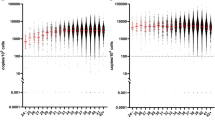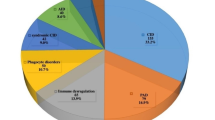Abstract
Common variable immunodeficiency (CVID) is the most common primary immunodeficiency of young adolescents and adults which also affects the children. The disease remains largely under-diagnosed in India and Southeast Asian countries. Although in majority of cases it is sporadic, disease may be inherited in a autosomal recessive pattern and rarely, in autosomal dominant pattern. Patients, in addition to frequent sino-pulmonary infections, are also susceptible to various autoimmune diseases and malignancy, predominantly lymphoma and leukemia. Other characteristic lesions include lymphocytic and granulomatous interstitial lung disease, and nodular lymphoid hyperplasia of gut. Diagnosis requires reduced levels of atleast two immunoglobulin isotypes: IgG with IgA and/or IgM and impaired specific antibody response to vaccines. A number of gene mutations have been described in CVID; however, these genetic alterations account for less than 20 % of cases of CVID. Flow cytometry aptly demonstrates a disturbed B cell homeostasis with reduced or absent memory B cells and increased CD21low B cells and transitional B cell populations. Approximately one-third of patients with CVID also display T cell functional defects. Immunoglobulin therapy remains the mainstay of treatment. Immunologists and other clinicians in India and other South East Asian countries need to be aware of CVID so that early diagnosis can be made, as currently, majority of these patients still go undiagnosed.
Similar content being viewed by others
References
Al-Herz W, Bousfiha A, Casanova JL, et al. Primary immunodeficiency diseases: an update on the classification from the International Union of Immunological Societies expert committee for primary immunodeficiency. Front Immunol. 2014;5:162.
Wehr C, Gennery AR, Lindemans C, et al. Multicenter experience in hematopoietic stem cell transplantation for serious complications of common variable immunodeficiency. J Allergy Clin Immunol. 2015;135:988–97.
Fuchs HB, Slater L, Novey H, Ong K, Gupta S. Immunological analysis in familial common variable immunodeficiency. Clin Exp Immunol. 1984;56:29–33.
Hammarstrom L, Smith CI. HLA-A, B, C and DR antigens in immunoglobulin A deficiency. Tissue Antigens 1983; 21:75–79.
Olerup O, Smith CI, Hammarstrom L. Different amino acids at position 57 of the HLA-DQ beta chain associated with susceptibility and resistance to IgA deficiency. Nature. 1990;347:289–90.
Schaffer FM, Palermos J, Zhu ZB, Barger BO, Cooper MD, Volanakis JE. Individuals with IgA deficiency and common variable immunodeficiency share polymorphisms of major histocompatibility complex class III genes. Proc Natl Acad Sci U S A. 1989;86:8015–9.
Alper CA, Marcus-Bagley D, Awdeh Z, et al. Prospective analysis suggests susceptibility genes for deficiencies of IgA and several other immunoglobulins on the [HLA-B8, SC01, DR3] conserved extended haplotype. Tissue Antigens. 2000;56:207–16.
De La Concha EG, Fernandez-Arquero M, Martinez A, et al. HLA class II homozygosity confers susceptibility to common variable immunodeficiency (CVID). Clin Exp Immunol. 1999;116:516–20.
Vorechovsky I, Cullen M, Carrington M, Hammarstrom L, Webster AD. Fine mapping of IGAD1 in IgA deficiency and common variable immunodeficiency: identification and characterization of haplotypes shared by affected members of 101 multiple-case families. J Immunol. 2000;164:4408–16.
vanShouwenburg PA, Davenport EE, Kienzler AK, et al. Application of whole genome and RNA sequencing to investigate the genomic landscape of common variable immunodeficiency disorders. Clin Immunol. 2015;160:301–14.
Fliegauf M, Bryant VL, Frede N, et al. Haploinsufficiency of the NF-κB1 subunit p50 in common variable immunodeficiency. Am J Hum Genet. 2015;97:389–403.
Cunningham-Rundles C. The many faces of common variable immunodeficiency. Hematol Am Soc Hematol Educ Program. 2012;2012:301–5.
Gathmann B, Mahlaoui N. CEREDIH, et al; European Society for Immunodeficiencies Registry Working Party. Clinical picture and treatment of 2212 patients with common variable immunodeficiency. J Allergy Clin Immunol. 2014;134:116–26.
Chapel H, Lucas M, Lee M, et al. Common variable immunodeficiency disorders: division into distinct clinical phenotypes. Blood. 2008;112:277–86.
Salzer U, Warnatz K, Peter HH. Common variable immunodeficiency- an update. Arthritis Res Ther. 2012;14:233. doi:10.1186/ar4032.
Ardeniz O, Cunningham-Rundles C. Granulomatous disease in common variable immunodeficiency. Clin Immunol. 2009;133:198–207.
Abolhassani H, Amirkashani D, Parvaneh N, et al. Autoimmune phenotype in patients with common variable immunodeficiency. J Investig Allergol Clin Immunol. 2013;23:323–9.
Quinti I, Soresina A, Spadaro G, et al. Long-term follow-up and outcome of a large cohort of patients with common variable immunodeficiency. J Clin Immunol. 2007;27:308–16.
Cunningham-Rundles C, Bodian C. Common variable immunodeficiency: clinical and immunological features of 248 patients. Clin Immunol. 1999;92:34–48.
Bloom KA, Chung D, Cunningham-Rundles C. Osteoarticular infectious complications in patients with primary immunodeficiencies. Curr Opin Rheumatol. 2008;20:480–5.
Fernández-Castro M, Mellor-Pita S, Citores MJ, et al. Common variable immunodeficiency in systemic lupus erythematosus. Semin Arthritis Rheum. 2007;36:238–45.
Daniels JA, Lederman HM, Maitra A, Montgomery EA. Gastrointestinal tract pathology in patients with common variable immunodeficiency (CVID): a clinicopathologic study and review. Am J Surg Pathol. 2007;31:1800–12.
Malamut G, Verkarre V, Suarez F, et al. The enteropathy associated with common variable immunodeficiency: the delineated frontiers with celiac disease. Am J Gastroenterol. 2010;105:2262–75.
Heneghan MA, Stevens FM, Cryan EM, Warner RH, McCarthy CF. Celiac sprue and immunodeficiency states: a 25-year review. J Clin Gastroenterol. 1997;25:421–5.
Mellemkjaer L, Hammarstrom L, Andersen V, et al. Cancer risk among patients with IgA deficiency or common variable immunodeficiency and their relatives: a combined Danish and Swedish study. Clin Exp Immunol. 2002;130:495–500.
López-Rocha E, Rodríguez-Mireles K, Segura-Méndez NH, Yamazaki-Nakashimada MA. Malignancies in adult patients with common variable immunodeficiency. [Article in Spanish]. Rev Alerg Mex. 2015;62:22–7.
Cunningham-Rundles C, Lieberman P, Hellman G, Chaganti RS. Non-Hodgkin lymphoma in common variable immunodeficiency. Am J Hematol. 1991;37:69–74.
Piquer Gibert M, Alsina L, Giner Muñoz MT, et al. Non-Hodgkin lymphoma in pediatric patients with common variable immunodeficiency. Eur J Pediatr. 2015;174:1069–76.
Taraldsrud E, Fevang B, Aukrust P, et al. Common variable immunodeficiency revisited: normal generation of naturally occurring dendritic cells that respond to toll-like receptors 7 and 9. Clin Exp Immunol. 2014;175:439–48.
Yu JE, Knight AK, Radigan L, et al. Toll-like receptor 7 and 9 defects in common variable immunodeficiency. J Allergy Clin Immunol. 2009;124:349–56.
Kutukculer N, Azarsiz E, Karaca NE, Ulusoy E, Koturoglu G, Aksu G. A clinical and laboratory approach to the evaluation of innate immunity in pediatric CVID patients. Front Immunol. 2015;6:145. doi:10.3389/fimmu.2015.00145. eCollection 2015.
Cambronero R, Sewell WA, North ME, Webster AD, Farrant J. Up-regulation of IL-12 in monocytes: a fundamental defect in common variable immunodeficiency. J Immunol. 2000;164:488–94.
Hong R, Agrawal S, Gollapudi S, Gupta S. Impaired pneumovax-23-induced monocyte-derived cytokine production in patients with common variable immunodeficiency. J Clin Immunol. 2010;30:435–41.
Aspalter RM, Sewell WA, Dolman K, Farrant J, Webster AD. Deficiency in circulating natural killer (NK) cell subsets in common variable immunodeficiency and X-linked agammaglobulinaemia. Clin Exp Immunol. 2000;121:506–14.
Carvalho KI, Melo KM, Bruno FR, et al. Skewed distribution of circulating activated natural killer T (NKT) cells in patients with common variable immunodeficiency disorders (CVID). PLoS One. 2010;5. doi:10.1371/journal.pone.0012652.
Ganjalikhani-Hakemi M, Yazdani R, Sherkat R, Homayouni V, Masjedi M, Hosseini M. Evaluation of the T helper 17 cell specific genes and the innate lymphoid cells counts in the peripheral blood of patients with the common variable immunodeficiency. J Res Med Sci. 2014;19:S30–5.
Casulli S, Coignard-Biehler H, Amazzough K, et al. Defective functions of polymorphonuclear neutrophils in patients with common variable immunodeficiency. Immunol Res. 2014;60:69–76.
Warnatz K, Schlesier M. Flow cytometric phenotyping of common variable immunodeficiency. Cytometry B Clin Cytom. 2008;74:261–71.
Roskin KM, Simchoni N, Liu Y, et al. IgH sequences in common variable immune deficiency reveal altered B cell development and selection. Sci Transl Med. 2015;7:302ra135.
Melo KM, Carvalho KI, Bruno FR, et al. A decreased frequency of regulatory T cells in patients with common variable immunodeficiency. PLoS ONE. 2009;4:e6269.
Carter CR, Aravind G, Smalle NL, Cole JY, Savic S, Wood PM. CVID patients with autoimmunity have elevated T cell expression of granzyme B and HLA-DR and reduced levels of treg cells. J Clin Pathol. 2013;66:146–50.
Genre J, Errante PR, Kokron CM, Toledo-Barros M, Câmara NO, Rizzo LV. Reduced frequency of CD4(+)CD25(HIGH)FOXP3(+) cells and diminished FOXP3 expression in patients with common variable immunodeficiency: a link to autoimmunity? Clin Immunol. 2009;132:215–21.
Vlkova M, Ticha O, Nechvatalova J, et al. Regulatory B cells in CVID patients fail to suppress multifunctional IFN-γ+TNF-α+CD4+ T cells differentiation. Clin Immunol. 2015;160:292–300.
Mahmoudi M, Hedayat M, Aghamohammadi A, Rezaei N. Soluble CD26 and CD30 levels in patients with common variable immunodeficiency. J Investig Allergol Clin Immunol. 2013;23:120–4.
Rösel AL, Scheibenbogen C, Schliesser U, et al. Classification of common variable immunodeficiencies using flow cytometry and a memory B-cell functionality assay. J Allergy Clin Immunol. 2015;135:198–208.
Contributions
BS: Wrote the manuscript; SG: Wrote, edited and finalized the manuscript. Prof. Surjit Singh, Professor of Pediatrics and Incharge Allergy Immunology Unit, Advanced Pediatrics Centre, Post Graduate Institute of Medical Education and Research (PGIMER), Chandigarh, will act as guarantor for the paper.
Author information
Authors and Affiliations
Corresponding author
Ethics declarations
Conflict of Interest
None.
Source of Funding
None
Rights and permissions
About this article
Cite this article
Saikia, B., Gupta, S. Common Variable Immunodeficiency. Indian J Pediatr 83, 338–344 (2016). https://doi.org/10.1007/s12098-016-2038-x
Received:
Accepted:
Published:
Issue Date:
DOI: https://doi.org/10.1007/s12098-016-2038-x




